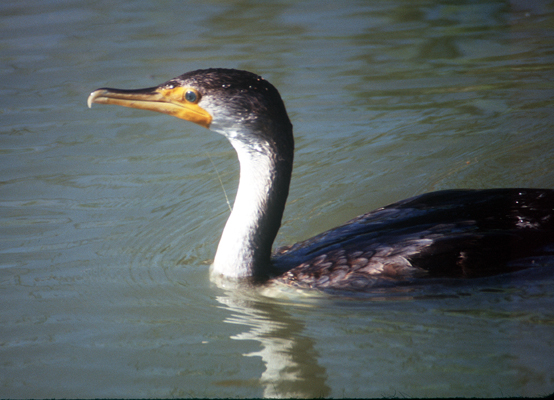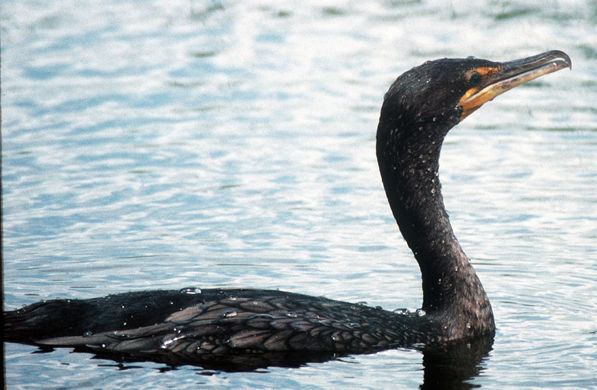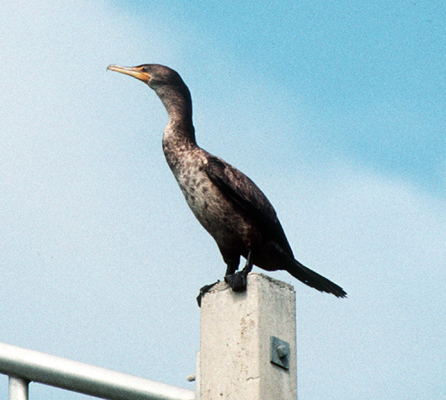|
Double-crested Cormorant Phalacrocorax auritus Corúa Crestada,
|
 |
|
Immature - Photo: G. Beaton
|
|
Double-crested Cormorant Phalacrocorax auritus Corúa Crestada,
|
 |
|
Immature - Photo: G. Beaton
|
|
IDENTIFICATION: A large, black waterbird with a hooked bill and an orange throat patch. Length: 70-90 cm.; weight: 1,200-2,500 g.
VOICE: Generally silent except for squawking notes at breeding colonies. The only sound most people ever hear a cormorant make is the noise their wings make as they take off. Audio (M. Oberle). HABITAT: Fresh and salt water ponds and lagoons. HABITS: The cormorant pursues fish under water, and has legs that are set far back on the body to aid in swimming. It also uses the legs to get a running start across the water to become airborne. Unlike some other diving birds, the cormorant’s feathers can get soaked upon entering the water, so the cormorant often spends long periods with its wings extended, drying the feathers in the sun. This species nests in North America, Cuba and the Bahamas, in trees or on the ground, on protected islands or cliffs. Both sexes build the nest in a breeding colony, and both incubate the 3-4 blue eggs for 25-29 days. Both sexes feed the young, which are able to fly 35-42 days after hatching. This species does not breed until 3 years of age. In China, Japan, and Europe, people used several species of cormorants to catch fish. They put a ring around the neck to prevent the bird from swallowing the fish. STATUS AND CONSERVATION: Formerly rare in Puerto Rico, this cormorant has become a regular visitor throughout Puerto Rico and Culebra. In North America, it has been persecuted by fishermen who fear competition and has also suffered from pesticide poisoning. However, the North American population has been stable or increasing under legal protection. RANGE: The Double-crested Cormorant breeds in North America on seacoasts and inland lakes and rivers, from western Alaska to Baja California and from eastern Canada to Florida; also in Cuba and the Bahamas. In winter, inland breeders move south as far as the Caribbean. TAXONOMY: PELECANIFORMES; PHALACROCORACIDAE |
|
 |
|
|
Adults - Photo: G. Beaton
|
 |
|
|
Adult - Photo: G. Beaton
|
 |
|
|
Immature - Photo: G. Beaton
|
 |
|
Adult - Photo: G. Beaton
|
 |
|
Immatures - Photo: G. Beaton
|
 |
|
Photo: G. Beaton
|
|
References Bent, A.C. 1922. Life histories of North American petrels and pelicans and their allies. Smithsonian Instit. U.S. National Museum Bull. 121. (Reprinted by Dover Press, NY, 1964). del Hoyo, J., A. Elliott, and J. Sargatal, eds. 1992. Handbook of Birds of the World, Vol. 1. Ostrich to ducks. Lynx Edicions, Barcelona. Ehrlich, P.R., D.S. Dobkin, and D. Wheye. 1988. The birder’s handbook: a field guide to the natural history of North American birds. Simon and Schuster/Fireside, NY. Hatch, J. J. and D. V. Weseloh. 1999. Double-crested Cormorant (Phalacrocorax auritus). in The birds of North America, No. 441 (A. Poole and F. Gill, eds.). The Birds of North America, Inc., Philadelphia, PA. Moskoff, W. 1998. Death in the nest: siblicide among birds. Birding 30(6):511-515. Pérez-Rivera, R.A. 1980. Algunas notas sobre migración de aves en Puerto Rico. Science-Ciencia 7(4):123-126. Raffaele, H.A. 1989. A guide to the birds of Puerto Rico and the Virgin Islands. Princeton. Raffaele, H.A. 1989. Una guía a las aves de Puerto Rico y las Islas Vírgenes. Publishing Resources, Inc., Santurce, PR. Raffaele, H.A., J.W. Wiley, O.H. Garrido, A.R. Keith, and J.I. Raffaele. 1998. Guide to the birds of the West Indies. Princeton. Williams, E. H. and L. Bunkley-Williams. 1993. Three unusual unusual marine bird records. Carib. J. Sci. 29:127. Double-crested Cormorant, Spanish text Next related species in taxonomic order Previous related species in taxonomic order |
|